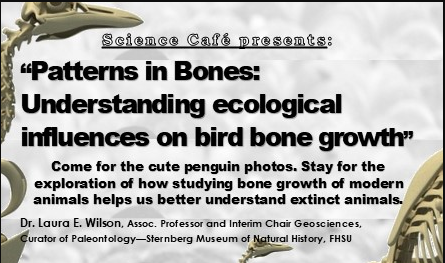BY NICHOLAS COUNTS
“I got lots of dead penguins, which is really, really exciting. So then I cut them up!” A statement that would be bizarre and downright disconcerting in any other context drew chuckles from the audience at FHSU’s Science Cafe Monday, February 24.
Geosciences Interim Chair and Sternberg Museum Chief Curator Dr. Laura Wilson gave a talk discussing her ongoing research into bird histology (the study of bone structure) and the paleoclimate of the Western Interior Seaway at Thirsty’s as a part of the monthly Science Cafe.
The FHSU Science Cafe is one of many Science Cafes across the globe. The Science Cafe website defines the events as a casual setting for engaging conversations with a scientist about a particular topic. They represent a “grassroots” movement that welcomes people who may or may not typically get involved with scientific discussion.
The Fort Hays State Science Cafe was started by former Geoscience chair John Heinrich and has been held almost monthly since 2008. The event has featured speakers of all different backgrounds and topics from across Fort Hays State’s science programs.
Although it sounds preposterous, Dr. Wilson’s penguin cadavers play a very important role in her research into the climate of the ancient Western Interior Seaway, an inland sea that once covered much of the American midwest and up into the Canadian Arctic. The penguins Dr. Wilson examines are from the extreme low latitude islands off of Antarctica, and are of three closely related species: the Adelie, Chinstrap, and Gentoo Penguins, and are shipped to her by scientists in the Antarctic Sea.
Looking at the bone growth structures in the femurs of the Adelie and Chinstrap penguins who migrate to avoid brutal antarctic winters reveals a continuous bone growth. Conversely, the bone growth of the Gentoo Penguin which overwinters in the antarctic shows dense clusters of vascular canals which indicate rapid growth as the Gentoo chicks try to reach adulthood in time for the winter.
The waters of the ancient Western Interior Seaway were inhabited by another seagoing bird. The Hesperornis was a flightless bird of the late Cretaceous with a comparable diving lifestyle to the modern penguin. Fossils of the Hesperornis have been collected throughout the latitudes of the seaway, as far south as Texas and as far north as the Northwest Territories within the Canadian Arctic. After examining the fossil femurs of Hesperornis found at high latitudes, Dr. Wilson has determined no identifiable changes in growth rates like the clusters of vascular canals present in the Gentoo penguins.
This leads to one of two conclusions, the first being that Hesperornis was a migratory animal like the Adelie and Chinstrap Penguins with similar patterns of bone growth. However, the more interesting conclusion is that the Northern latitudes of the Late Cretaceous world were not as cold and inhospitable as they are today, and a dramatic period of growth during overwintering was not necessary for the animal’s survival.
Regardless of the outcomes of the research, Dr. Wilson said the mission of Science Cafe making science more accessible is very important.
“It helps people enjoy a lifestyle of lifelong learning, always learning new things and getting new perspectives,” Wilson said. “All of science is about asking questions and trying to figure out how to answer those questions because its important for people to always be asking questions and finding ways to answer them in every aspect of their life.”

